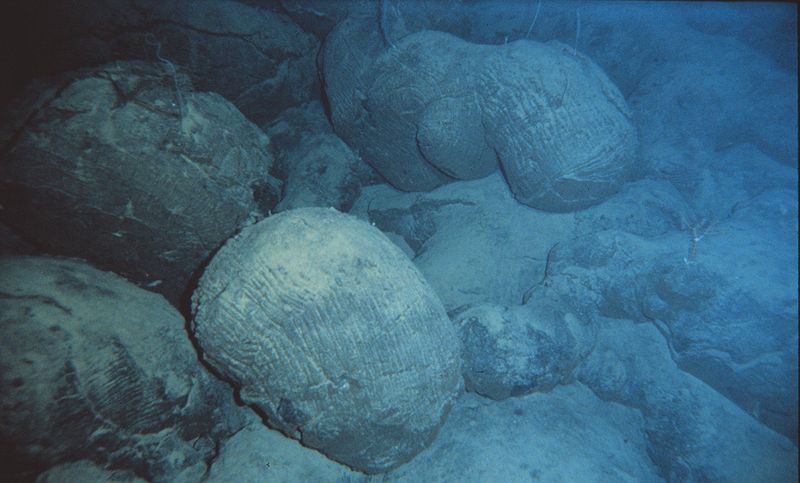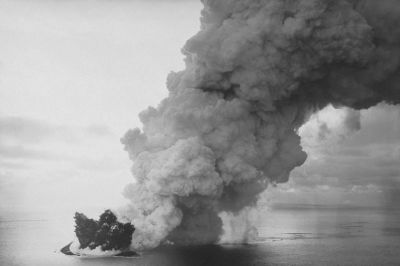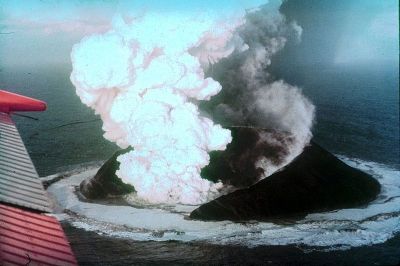Underwater Volcanoes
Volcanic eruptions not limited to the areas of dry land. They can occur anywhere where the conditions are right. Many of the most active plate margins are on the sea floor, so it is no surprise to discover that the ocean's depths conceal long chains of volcanoes, some far larger than any on dry land.
The processes that form volcanoes are essentially the same above and below water, and are linked to plate tectonics , hotspots and plate boundaries.
The conditions under water are different to those on dry land; there's a lot of water (obviously) and that means more pressure and a lower temperture, both of which have an influence on how the volcano forms and how it is weathered.
There are several hundred known submarine volcanoes, ranging from the relatively small through to volcanoes such as Kawio Barat, an underwater volcano off the coast of Indonesia, which has recently been estimated to be 10,000 feet tall and sitting in more than 18,000 feet of water.
Submarine volcanoes are not confined to particular depths of water; they form in shallow and deep water areas, however the way in which they erupt is controlled by the depth of water.
Imagine a volcanic eruption as being nature's way of balancing out pressure. Under the Earth's surface there is magma under huge pressure. When a volcano erupts the magma works it way through to the Earth's surface. If the surface happens to be on dry land the pressure pushing down on the escaping magma is low - just one atmosphere- and the volcano has the potential to produce a violent eruption with steam, ash, chunks of lava thrown into the air etc. This is possible because there is a big difference in pressure between where the magma comes from and where it ends up.
In deep water the same process applies but when the magma reaches the surface it is met by a much greater pressure. The base of Kawio Barat is 5500m (18,000 feet) below sea level and magma reaching the surface there is met by 545 times more presure pushing down on it than a volcano at sea level on dry land. At such pressures steam clouds cannot form, and material cannot be thrown up from the volcano as we see when a land volcano throws ash and rock into the air.
Magma reaches the surface, becomes lava, and immediately has contact with very cold high pressure water. This limits the force of the eruption in two ways. The pressure keeps the flow of ejected material less rapid, and the cold temperature rapidly cools and sets the surface of the new lava. The rapid formation of a solid skin on the lava slows it down and acts as an additional restraint on its movement.
Watching lava erupt in cold water is like watching toothpaste squeezed from a tube. A rope of lava breaks through the surface and is squeezed out. The surface sets hard and pressure builds up inside the rock until a weak point cracks and more lava is squeezed out. The new surfaces set quickly and the process is repeated. These repeated squirts of lava produce a formation known as pillow lava, named after their curved and puffy shape.

Pillow lava rocks on the slope off Hawaii. Photographed in 1988
In more shallow water the pressure is less and the eruption can appear to be more like a land based volcano. In November 1963 fishermen working off the coast of Iceland witnessed an explosion under the sea. This was followed by smoke, steam and emissions of pumice stone into the air. iceland is positioned on the Mid-Atlantic ridge, and the new explosion was yet another example of volcanic activity accociated with the parting of the two plates. On the sea bed, 130m ( 425 feet) below the surface, a new volcanic eruption had started and was producing an ever growing cone of ash. The cone eventually broke through the surface and the island of Surtsey was created.
A cone of ash is vulnerable to weathering by wave action so the island / volcano wasn't likely to survive. However, on the 4th April 1964, a lava flow covered the entire island surface and thus ensured that the island would survive.
 |
 |
| Ash and steam rise from the sea in 1963 | The cone rises above the sea surface in 1964 |
![]()
